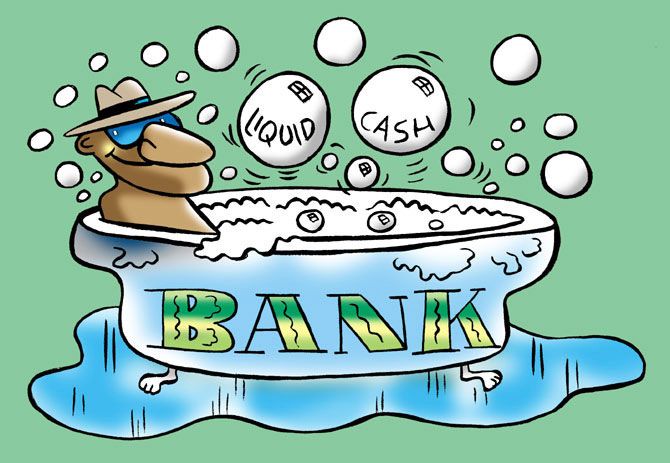The banking sector is much better placed to handhold India Inc, but it’s still too early to sing “Happy days are here again!”
Abhijit Lele & Raghu Mohan report.

Is the worst over for Indian banks?
The past two years saw them ride on treasury trades as deposits soared and credit growth dipped sharply.
Gross and net non-performing assets (NPAs) moved south, and the provision coverage ratio (PCR), capital buffers, and profitability indicators are back at pre-pandemic levels.
So, what’s the plot ahead?
The Reserve Bank of India’s (RBI’s) Report on Trend and Progress of Banking in India 2020-21 (T&P: FY21) is nuanced: “A pick-up has started in Q2:2021-22, with the economy emerging out of the shadows of the second wave of Covid-19.
"Going forward, revival in bank balance sheets hinges around overall economic growth, which is contingent on progress on the pandemic front.”
We are on that trajectory, but the report had added: “Banks would have to bolster their capital positions to absorb potential slippages as well as to sustain the credit flow, especially when monetary and fiscal measures unwind.”
Last month, the second advance estimates of the National Statistical Office placed GDP growth at 8.9 per cent in FY22, lower than the earlier estimate of 9.2 per cent.
GDP growth for the October-December quarter is seen at 5.4 per cent, as against 0.7 per cent in the corresponding period a year ago.
The RBI, in its February bi-monthly policy, had pegged growth in FY23 at 7.8 per cent, down from 9.2 per cent expected in FY22, in view of pandemic-induced uncertainties and elevated global commodity prices.
This is also lower than the 8-8.5 per cent projected by the Economic Survey.
RBI Governor Shaktikanta Das had observed that “recovery in domestic economic activity is yet to be broad-based, as private consumption and contact-intensive services remain below pre-pandemic levels.”
The GDP growth numbers may have to be revisited in light of the conflict in Ukraine.
Bankers, however, appear relatively optimistic; and the underlying mood is that various positive strands are coming together.
Gearing up
Rajkiran Rai G, managing director (MD) and chief executive officer (CEO) of Union Bank of India, believes that “legacy issues are behind us and we have comfortable capital adequacy, high PCR, and a re-hauled risk management system” — as well as the ability to take on large exposures, far better human resources, and technology systems.
Rai adds: “The capital investment cycle has begun, which leads to good credit growth and our market share in incremental business will stabilise in FY23.”
Amitabh Chaudhry, MD and CEO of Axis Bank, reckons that “capitalisation is much better, asset quality deterioration, adjusted even for regulatory forbearance, has surprised us in its moderation.
"It points to the robust risk management systems implemented in banks.” He takes comfort from the RBI’s projections of gross-NPAs in its Financial Stability Report of December 2021, which sees only a slight deterioration to 8.1 per cent under the “base scenario”, and 9.5 per cent under the “severe-stress scenario” in September 2022, from 6.9 per cent in September 2021.
“The regulatory and fiscal measures have been timely and effective.
"The overall economy has recovered well from the earlier Covid waves, and looks set to maintain the recovery trend.
"The Union Budget and recent monetary policy indicates a pro-growth focus and gradual withdrawal of support measures,” notes Sumant Kathpalia, MD and CEO of IndusInd Bank.
He’s hopeful of “a seamless transition to a post-Covid economy.
"The banking sector has coped well through stronger balance sheets and digital adoption.
"We are poised to participate in the growth recovery.”
Niggling doubts
The material change in the equation is interest rates.
Another way of putting it is that the repeal of RBI’s accommodative monetary policy stance is a variable in play now.
Unlike the year gone by, it is clear that from here on, the money markets and yields on dated-securities will be watched keenly.
This should be seen in the context of the fact that credit demand is beginning to improve, with non-food credit growth rising to 8.3 per cent year-on-year in January 2022, from a low of 5.4 per cent in April 2021.
Retail continues to be the major driver, accounting for around 37 per cent of the incremental off-take until Q3 of FY22.
Services, agriculture and MSMEs (micro, small and medium enterprises) are also witnessing healthy credit demand, including disbursement to non-banking financial companies (NBFCs) for on-lending.
“However, real pick-up in credit will be dependent on government spending and private capital expenditure going up.
"While conversations have started, we are yet to see a real pick-up in activity on the ground,” Chaudhry qualifies.
But will higher interest rates trip the growth story from here on?
The macroeconomic setting is as follows: gross borrowing for FY23(BE) is at Rs 14.95 trillion, compared to Rs 10.47 trillion in FY22(RE); and repayments are likely to be higher at Rs 3.76 trillion, compared to Rs 2.7 trillion in FY22(RE). So, too, are the total liabilities of the Centre, at Rs 152 trillion in FY23 (Rs 136 trillion in FY22).
Interest costs are seen elevated at Rs 9.4 trillion in FY23(BE), compared to Rs 8.14 trillion in FY22(RE).
The yield on the benchmark 10-year government paper is seen inching upward to 7 per cent.
Banks have already adjusted their deposit rates higher; and it’s only a matter of time before this feeds into the pricing of loans.
Now, look at another data-set.
The credit-to-GDP ratio is at a five-year high, narrowing the credit-GDP gap (a caveat: this is also due to the fact that GDP growth has slowed down). That said, the credit-to-GDP ratio is still markedly lower than the G-20 average.
The share of advances (in total assets) is down; that of investments is up, owing to banks’ risk aversion and limited profitable lending avenues.
This has led to a decline in the credit-deposit (CD) ratio and an elevation in the investment-deposit (ID) ratio, especially in incremental terms.
The RBI may also have to be a bit realistic for banks to handhold India Inc, and improve the ease of doing business. For instance, the move to impose restrictions on opening of current accounts and cash-credit or overdraft facilities by banks (relaxed now by six months to October 29, 2022), has created an operational nightmare for banks.
“It was intended to curb fund-diversion, but has ended up hurting the good borrowers as well,” says a senior banker.
Then, again, while sectoral buoyancy is back, it is unlikely that banks of all hues are able to service their needs, given the limitations on capital.
The RBI’s Report on Trend and Progress of Banking in India 2018-19 had flagged the sharp fall in both the incremental and outstanding credit of state-run banks.
(And this aspect has to be read along with the aforementioned fall in the CD ratio and the uptick in the ID ratio.)
In FY17, private banks’ share in incremental credit was almost 100 per cent, as a dozen state-run banks which were under the RBI’s prompt corrective action (PCA) framework had vacated their turf.
Will state-run banks be major lenders henceforth?
The Centre will not to capitalise them: no support has been earmarked in the Union Budget for FY23.
Between 2015-16 and 2019-20, the Centre had pumped in Rs 3.56 trillion into these banks through both direct subscription to equity shares and recapitalisation bonds.
With valuations low, the Centre’s stake in state-run banks had shot up.
Will investors now supply them with capital, if it is felt that on full withdrawal of pandemic-related forbearance measures, bad loans are about to rear their head again?
Karthik Srinivasan, group head, financial sector ratings, at ICRA, points out that “the story for state-run banks is changing for the better on improving core profitability and low provisioning requirements.”
For many of them, a good two years was taken in ensuring that the amalgamations were effective, even as they grappled with the effects of Covid-19.
“They have the management bandwidth to scale up and are in a position to support 8-9 per cent growth in credit in FY23,” he adds.
As for NBFCs that have taken on the task of fuelling the economy over the last decade, there is still lingering pain.
That’s why the RBI has given an additional six months to comply with its circular which said that NPAs can be upgraded only after all arrears and principal dues are paid.
“We believe it could have been helpful if the measures extending the revised asset classification and provisioning norms had come along with the RBI circular issued on 12th November, 2021.
"Most NBFCs have already absorbed the impact in their third-quarter FY22 results,” says Y S Chakravarti, MD and CEO of Shriram City Union Finance.
That’s because the RBI clarification only defers the adoption of the new norms.
“Reversing the provisions already made (although now permitted), is unlikely to be the route that NBFCs may follow due to accounting complexities,” he adds.
Taken together, the banking sector is much better placed to handhold India Inc, but it’s still too early to sing “Happy days are here again!”











